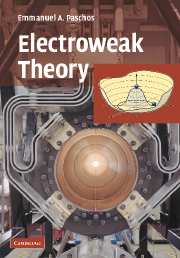Book contents
- Frontmatter
- Contents
- Preface
- Part I The road to unification
- Part II Field theories with global or local symmetries
- Part III Experimental consequences and comparisons
- 10 Deep inelastic scattering
- 11 Charged-current reactions
- 12 Neutral currents in semileptonic reactions
- 13 Physics of neutrinos
- 14 Heavy quarks
- 15 CP violation: K mesons
- 16 CP violation: D and B mesons
- 17 Higgs particles
- Epilogue
- Appendix A Conventions, spinors, and currents
- Appendix B Cross sections and traces
- Appendix C Identities for quark bilinears
- Index
11 - Charged-current reactions
Published online by Cambridge University Press: 03 December 2009
- Frontmatter
- Contents
- Preface
- Part I The road to unification
- Part II Field theories with global or local symmetries
- Part III Experimental consequences and comparisons
- 10 Deep inelastic scattering
- 11 Charged-current reactions
- 12 Neutral currents in semileptonic reactions
- 13 Physics of neutrinos
- 14 Heavy quarks
- 15 CP violation: K mesons
- 16 CP violation: D and B mesons
- 17 Higgs particles
- Epilogue
- Appendix A Conventions, spinors, and currents
- Appendix B Cross sections and traces
- Appendix C Identities for quark bilinears
- Index
Summary
Charged-current interactions are the most frequent and occur in decays, as well as in particle reactions. They have been analyzed in many books, especially those written before 1970. Charged-current interactions, especially decays, were instrumental in establishing properties of the currents. We can classify them according to the degree of our theoretical understanding. The simplest reactions are purely leptonic. They are relatively simple to calculate, because the couplings of leptons to currents are precisely known and, now that the theory is renormalizable, we can include loop corrections. Some leptonic reactions were presented in Chapter 8. We shall not study them further.
The next class of reactions consists of the semileptonic ones, which can also be treated successfully with various theoretical methods. They involve a single coupling of the currents to hadrons, which can be understood at low energy and/or at low momentum transfer in terms of form factors. They are also understood at high energies in terms of the short-distance behavior of the currents. We shall study several processes in this chapter: deep inelastic scattering and quasi-elastic scattering.
Non-leptonic interactions are the most difficult to analyze. They do not include any leptons and involve both strong and weak interactions. The interplay between the two interactions is still a developing field of research.
Deep inelastic scattering
High-energy neutrino interactions have been used to probe the inner structure of protons and neutrons: these studies were crucial for establishing the quark substructure of matter and giving quantitative support to the field theory of quark interactions (quantum chromodynamics). In Chapter 10 we described the general structure of the cross sections and some consequences of the scaling phenomenon.
- Type
- Chapter
- Information
- Electroweak Theory , pp. 112 - 123Publisher: Cambridge University PressPrint publication year: 2007

